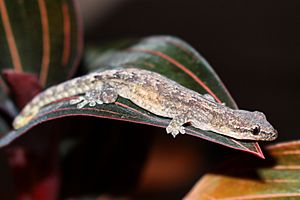Lepidodactylus lugubris facts for kids
Quick facts for kids Lepidodactylus lugubris |
|
|---|---|
 |
|
| Conservation status | |
| Scientific classification | |
| Synonyms | |
|
The Lepidodactylus lugubris, often called the mourning gecko or common smooth-scaled gecko, is a type of lizard. It belongs to the Gekkonidae family, which includes all geckos. These small geckos are known for their unique way of reproducing.
Contents
What They Look Like
Mourning geckos are quite small. They grow to about 8.5 to 10 centimeters (3.3 to 4 inches) long. This measurement includes their tail. Their body, from snout to vent, is about 4 to 4.4 centimeters (1.6 to 1.7 inches).
These geckos have colors that help them blend in. They are usually light to dark tan. They have dark spots along their back. A brown stripe runs from their ear to the tip of their nose. What's cool is they can change their color! The same gecko might look light at one time and dark at another. This helps them hide from predators.
Behavior and Life
Mourning geckos are mostly active at night. This means they are nocturnal. Sometimes, you might see them during the day. If so, they are usually close to a safe hiding spot.
Reproduction
One of the most amazing things about mourning geckos is how they reproduce. Almost all of them are female! They can lay eggs without a male gecko. This special process is called parthenogenesis. It means the females can create babies all by themselves.
Male mourning geckos are very rare. When they do appear, they often cannot have babies. Female geckos lay one or two eggs at a time. They glue these eggs to surfaces in safe, hidden places. A female gecko can lay a new set of eggs every 4 to 6 weeks.
Where They Live
Mourning geckos are found in many places around the world. They live in coastal areas near the Indian Ocean and Pacific Ocean. This includes countries like the Maldives, Sri Lanka, India, Myanmar, and Malaysia. You can also find them in Hawai'i, Japan, China, and Australia.
They have also been moved to new places by people. These are called introduced species. For example, they now live in parts of Central and South America. This includes Mexico, Brazil, Costa Rica, and Ecuador. They have also been introduced to the Seychelles islands.
What They Eat
Mourning geckos are omnivorous. This means they eat both plants and animals. In the wild, they have a varied diet. They eat insects, spiders, and other small creatures. They also enjoy fruit, nectar, and pollen. Sometimes, they even eat their own eggs!
If they get the chance, they will also eat human foods. This includes jam, sugar, sweet drinks, and milk.
Keeping Them as Pets
Mourning geckos are sometimes kept as pets. They are popular because they are easy to care for. They also tend to be social with each other. Since they reproduce through parthenogenesis, they breed very well in captivity. This means most pet geckos were born in someone's home, not caught from the wild.
See also
 In Spanish: Gecko enlutado para niños
In Spanish: Gecko enlutado para niños


